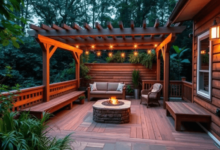Crafting Resilient Residential Spaces: Principles of Modern Home Construction

Modern home construction has transformed significantly over the past few decades, driven by advancements in building materials, design approaches, and sustainability standards. Today’s residential projects often incorporate energy-efficient systems, smart home technology, and environmentally conscious designs that reflect shifting homeowner priorities. While traditional craftsmanship remains essential, integrating new methods and technologies has changed how homes are planned, built, and maintained, offering greater flexibility and improved performance.
In regions experiencing rapid growth, such as urban areas and suburban developments, builders must balance modern expectations with practical execution. Commercial contractors Denver, for example, are frequently involved in residential projects that require technical expertise and familiarity with local regulations and conditions. These professionals often work alongside architects, engineers, and developers to ensure that homes meet current standards for safety, functionality, and environmental impact, reflecting broader trends in modern construction.
Foundational Elements of Modern Homes
At the heart of contemporary home construction is flexibility. Modern homes are built with adaptability in mind, allowing for spaces that can change in function as needed. This concept is reflected in open floor plans and multifunctional rooms that quickly transform to meet the dynamic needs of families. Applying design principles that prioritize space efficiency and adaptability ensures that homes remain relevant to their occupants’ lifestyles over time, avoiding rapid obsolescence and fostering a living environment that feels both comfortable and efficient.
See also: The Pros and Cons of Living in Muraba Veil
Sustainable Materials for Resilient Housing
Environmentally conscious materials have become a staple in resilient house construction. Builders and architects increasingly turn to options like locally sourced timber, bamboo, hempcrete, and recycled metals, which offer reduced carbon footprints and enhanced durability. These new structural materials do not only serve the planet but often provide superior performance characteristics. Choosing materials with sustainable credentials supports the planet’s health and the structure’s performance, ensuring longevity and resilience in changing environmental conditions.
Smart Technology: The Future of Home Living
Incorporating smart technology in homes adds convenience and fundamentally transforms how homeowners interact with their living spaces. This technology can range from smart thermostats and lighting systems to security cameras and automated climate controls. Managing energy consumption remotely enables homeowners to optimize their resource use, leading to financial savings and a reduced environmental footprint. Current trends in home automation also highlight innovations like voice-activated assistants and integrated ecosystems that enhance comfort and efficiency in daily living.
Enhancing Indoor Air Quality
The indoor air quality significantly affects the health and wellness of those living there. To promote clean air, modern homes often feature advanced HVAC systems with high-efficiency particulate air (HEPA) filters that effectively remove pollutants and allergens. Selecting construction materials that emit minimal VOCs further ensures a healthier indoor environment. Employing these strategies means residents can breathe more easily and healthily, improving overall health outcomes and greater daily comfort within the home.
Energy Efficiency in Home Design
Improving energy efficiency is a crucial aspect of living sustainably in the 21st century. Innovations in this area include high-performance insulation, triple-glazed windows, and advanced framing techniques that minimize heat transfer and maximize efficiency. Passive solar design principles, which utilize the sun’s energy for heating and cooling, are also increasingly implemented. Combined, these elements significantly reduce a home’s energy demand, directly translating to lower utility costs and less strain on natural resources, embodying a responsible energy-use approach.
The Role of Architecture in Resilient Home Design
Architectural innovation is essential in crafting homes that thrive amidst environmental challenges. Innovative solutions like strategically designed rooflines, rainwater collection systems, and natural light maximization through carefully positioned windows enhance a home’s appeal and functionality. These architectural strategies help manage resources efficiently and build resilience against climatic and environmental extremes, solidifying the home’s longevity.






